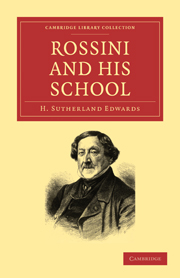Book contents
- Frontmatter
- Contents
- CHAP. I ROSSINI'S CHILDHOOD AND YOUTH
- CHAP. II LA PIETEA DEL PARAGONE
- CHAP. III ITALIAN OPERA UNTIL THE TIME OF ROSSINI
- CHAP. IV TANCREDI
- CHAP. V OPERATIC CUSTOMS IN ROSSINI'S TIME
- CHAP. VI ROSSINI AT NAPLES
- CHAP. VII PREPARATIONS FOR THE BARBER
- CHAP. VIII IL BARBIERE
- CHAP. IX ROSSINI AND THE COMIC IN MUSIC
- CHAP. X FROM OTELLO TO SEMIKAMIDE
- CHAP. XI ROSSINI ON HIS TRAVELS
- CHAP. XII DONIZETTI
- CHAP. XIII VERDI
- LIST OF ROSSINI'S PUBLISHED WORKS
CHAP. II - LA PIETEA DEL PARAGONE
Published online by Cambridge University Press: 29 August 2010
- Frontmatter
- Contents
- CHAP. I ROSSINI'S CHILDHOOD AND YOUTH
- CHAP. II LA PIETEA DEL PARAGONE
- CHAP. III ITALIAN OPERA UNTIL THE TIME OF ROSSINI
- CHAP. IV TANCREDI
- CHAP. V OPERATIC CUSTOMS IN ROSSINI'S TIME
- CHAP. VI ROSSINI AT NAPLES
- CHAP. VII PREPARATIONS FOR THE BARBER
- CHAP. VIII IL BARBIERE
- CHAP. IX ROSSINI AND THE COMIC IN MUSIC
- CHAP. X FROM OTELLO TO SEMIKAMIDE
- CHAP. XI ROSSINI ON HIS TRAVELS
- CHAP. XII DONIZETTI
- CHAP. XIII VERDI
- LIST OF ROSSINI'S PUBLISHED WORKS
Summary
Rossini had already written two operas in 1812, and he was destined in this fertile year to produce three more: two at Venice, La Scala di Seta and L'Occasione fa il Ladro; and one at Milan, La Pietra del Paragone.
La Pietra del Paragone was Rossini's next great success after L'lnganno Felice. The leading parts were assigned to G-alli, afterwards one of the most famous bass-singers of his time, and to Madame Marcolini, who had played the principal character in L'Equivoco Stravagante, and who had particularly distinguished herself in that work by her singing of the final rondo before mentioned.
In La Pietra del Paragone Madame Marcolini was furnished with a final rondo of the pattern already approved, and in this, as in the earlier one, she gained a most brilliant success.
The libretto of La Pietra del Paragone is founded on an idea at least as old as that of Timon of Athens. Count Asdrubal, surrounded by friends and beloved by a charming young lady, is rash enough to wish to know whether the friendship and the love he seems to have inspired are due to himself and his own personal qualities, or to the riches he is known to possess. To determine the point he causes a bill of exchange for a large sum to be presented at his house. He himself appears in disguise to claim the money; and, in accordance with instructions given beforehand, the count's steward recognises the signature and honours the draft.
- Type
- Chapter
- Information
- Rossini and his School , pp. 11 - 18Publisher: Cambridge University PressPrint publication year: 2009First published in: 1881



